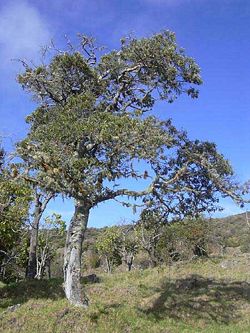Description
Alphitonia ponderosa is a medium to large tree, reaching 15–24 m (49–79 ft) high with a trunk 20–60 cm (7.9–23.6 in) in diameter. [2]
Leaves
The alternate leaves are ovate, 5–15 cm (2.0–5.9 in) long, and have 13–25-millimetre (0.51–0.98 in) petioles. The leaves are shiny, hairless, and green on the top, but are a dull light green with rust-colored veins on the bottom. [2]
Flowers
Flowers of A. ponderosa are polygamous and form cymes at the bases of leaves. They are 6 mm (0.24 in) in diameter; the five sepals are 1.5 mm (0.059 in) and cover five 0.75-millimetre (0.030 in) petals. [2]
Fruit
The fruit of A. ponderosa is a 15-millimetre (0.59 in) diameter drupe, which contain two to three seeds. The seeds are shiny, oblong, and have a red covering. [2]
Uses
The reddish-brown wood of A. ponderosa is highly prized for its beauty, strength, and density. It was used as a replacement for metal by the Native Hawaiians, [2] who made laʻau melomelo (fishing lures), pāhoa (daggers), ihe (short spears), pololū (long spears), ʻōʻō (digging sticks), hohoa (round kapa , beaters)ʻiʻe kūkū (square kapa beaters), leiomano (shark tooth clubs), and kiʻi (tiki carvings) with it. [4]
This page is based on this
Wikipedia article Text is available under the
CC BY-SA 4.0 license; additional terms may apply.
Images, videos and audio are available under their respective licenses.


